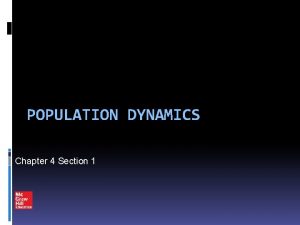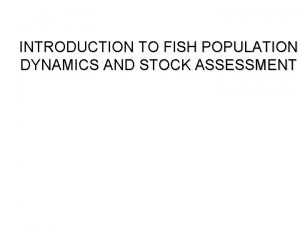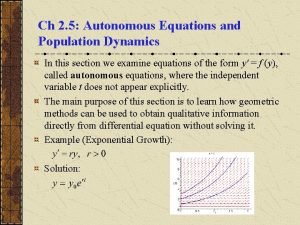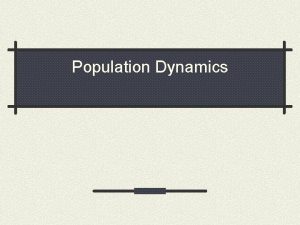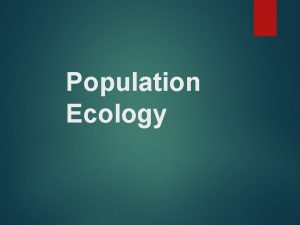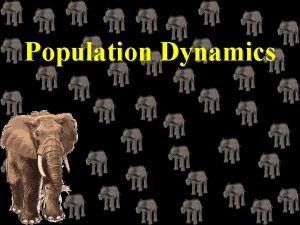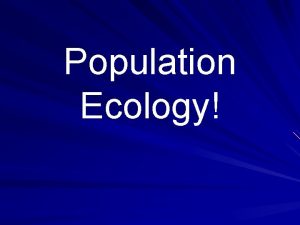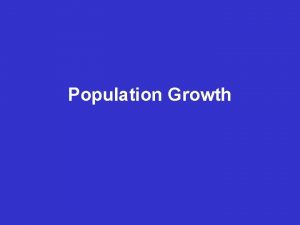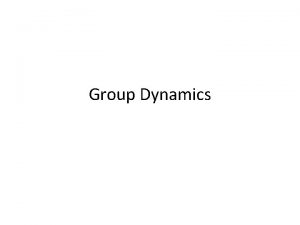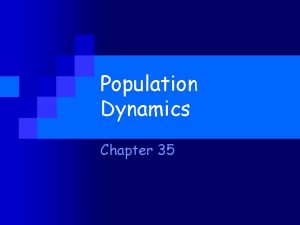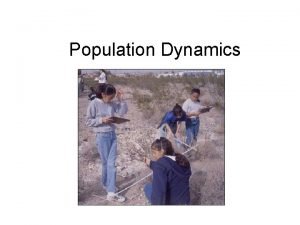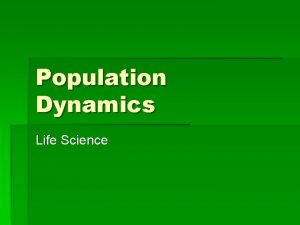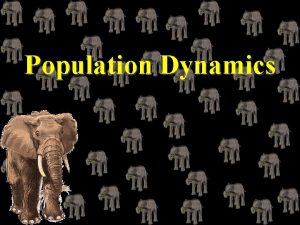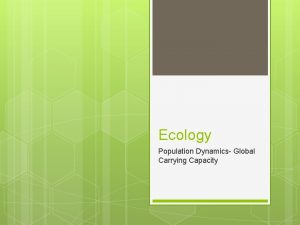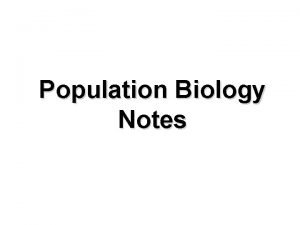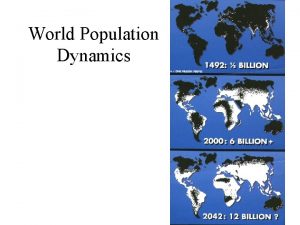Population Dynamics Population Dynamics Population all the individuals
































- Slides: 32

Population Dynamics

Population Dynamics Population: all the individuals of a species that live together in an area Demography: the statistical study of populations, make predictions about how a population will change

Population Dynamics Three Key Features of Populations • Size • Density • Dispersion • (clumped, even/uniform, random) • Age Structure

Three Key Features of Populations 1. Size: number of individuals in an area

Factors That Affect Future Population Growth Immigration Natality + + Population Emigration - Mortality

4 Factors that affect density 1. Immigration- movement of individuals into a population 2. Emigration- movement of individuals out of a population

Three Key Features of Populations Growth Rate= Birth Rate (natality) - Death Rate (mortality) X Total Population OR Change in Population X 100 Original Population Rate of Natural Increase(r)= Birth Rate (b) − Death Rate (d) 100

Three Key Features of Populations 2. Density: measurement of population per unit area or unit volume Formula: Dp= N S Pop. Density = # of individuals ÷ unit of space


4 Factors that affect density 3. Density-dependent factors- Biotic factors in the environment that have an increasing effect as population size increases Ex. disease competition parasites

4 Factors that affect density 4. Density-independent factors. Abiotic factors in the environment that affect populations regardless of their density Ex. temperature storms habitat destruction drought


Developing vs. Developed Countries Developing • Less industrialized • Lower per capita income • Less stable government • Poorer living conditions • Higher infant mortality rate • Lower life expectancy Developed • More industrialized • Higher per capita income • More stable government • Better living conditions • Lower infant mortality rate • Higher life expectancy

POSTREPRODUCTIVE PREREPRODUCTIVE

Population of a Stable Country

You decide!

Other factors that affect population growth Carrying Capacity- the maximum population size that can be supported by the available resources There can only be as many organisms as the environmental resources can support

PREDICTING POPULATION GROWTH, con’t Two modes of population growth. The Exponential curve (also known as a Jcurve) occurs when there is no limit to population size. The Logistic curve (also known as an S-curve) shows the effect of a limiting factor (in this case the carrying capacity of the environment).

Carrying Capacity Nu m J-shaped curve (exponential growth) Carrying Capacity (k) b S-shaped curve (logistic growth) e r Time


2 Life History Patterns 1. R Strategists § § § short life span small body size reproduce quickly have many young little parental care Ex: cockroaches, weeds, bacteria

2 Life History Patterns 2. K Strategists § long life span § large body size § reproduce slowly § have few young § provides parental care § Ex: humans, elephants

Survivorship Curves

Human Population Growth


Human Population Growth

Other factors that affect population growth Limiting factor- any biotic or abiotic factor that restricts the existence of organisms in a specific environment. n EX. - Amount of water Amount of food Temperature

Limiting Factor- Zone of Tolerance None Few organisms present Many organisms present Few None organisms present

Current Human Population Trends Global human population is currently over 7 billion. Globally, the population is still increasing. Most growth is occurring in the developing world. Earth’s carrying capacity is 9 -10 billion due to available food.

Current Human Population Trends China is currently the most populous country at around 1. 4 billion people, followed closely by India’s population will surpass China’s by 2050 due to a higher growth rate. The US is 3 rd in terms of population at over 325 million people.

Current Human Population Trends

Controlling Population Growth Demographers believe growth can be slowed by: 1) Education (family planning) 2) Reducing poverty 3) Increasing women’s status
 Chapter 4 section 1 population dynamics
Chapter 4 section 1 population dynamics Population ecology section 1 population dynamics answer key
Population ecology section 1 population dynamics answer key Population ecology section 1 population dynamics
Population ecology section 1 population dynamics Population ecology chapter 4 answers
Population ecology chapter 4 answers Name three lines
Name three lines Chapter 4 section 1 population dynamics
Chapter 4 section 1 population dynamics Chapter 4 section 1 population dynamics answer key
Chapter 4 section 1 population dynamics answer key Galapagos
Galapagos Fish population dynamics and stock assessment
Fish population dynamics and stock assessment Autonomous equations and population dynamics
Autonomous equations and population dynamics Hát kết hợp bộ gõ cơ thể
Hát kết hợp bộ gõ cơ thể Lp html
Lp html Bổ thể
Bổ thể Tỉ lệ cơ thể trẻ em
Tỉ lệ cơ thể trẻ em Chó sói
Chó sói Glasgow thang điểm
Glasgow thang điểm Bài hát chúa yêu trần thế alleluia
Bài hát chúa yêu trần thế alleluia Các môn thể thao bắt đầu bằng tiếng đua
Các môn thể thao bắt đầu bằng tiếng đua Thế nào là hệ số cao nhất
Thế nào là hệ số cao nhất Các châu lục và đại dương trên thế giới
Các châu lục và đại dương trên thế giới Công thức tính thế năng
Công thức tính thế năng Trời xanh đây là của chúng ta thể thơ
Trời xanh đây là của chúng ta thể thơ Mật thư anh em như thể tay chân
Mật thư anh em như thể tay chân 101012 bằng
101012 bằng Phản ứng thế ankan
Phản ứng thế ankan Các châu lục và đại dương trên thế giới
Các châu lục và đại dương trên thế giới Thơ thất ngôn tứ tuyệt đường luật
Thơ thất ngôn tứ tuyệt đường luật Quá trình desamine hóa có thể tạo ra
Quá trình desamine hóa có thể tạo ra Một số thể thơ truyền thống
Một số thể thơ truyền thống Bàn tay mà dây bẩn
Bàn tay mà dây bẩn Vẽ hình chiếu vuông góc của vật thể sau
Vẽ hình chiếu vuông góc của vật thể sau Thế nào là sự mỏi cơ
Thế nào là sự mỏi cơ đặc điểm cơ thể của người tối cổ
đặc điểm cơ thể của người tối cổ





